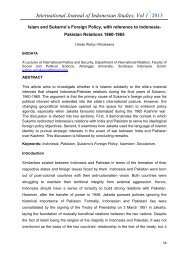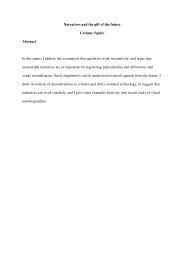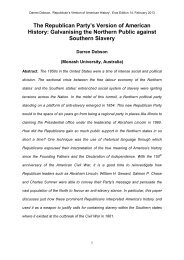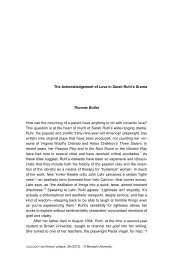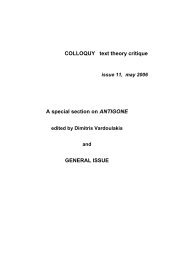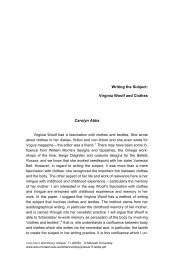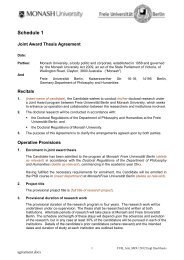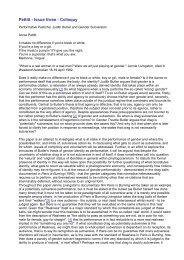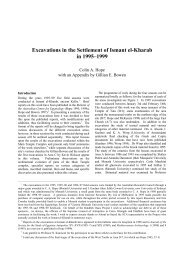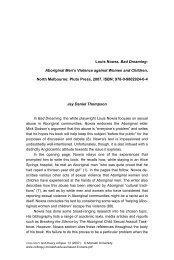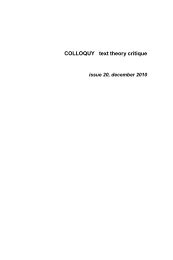Prince Charming by Day, Superheroine by Night? - Arts - Monash ...
Prince Charming by Day, Superheroine by Night? - Arts - Monash ...
Prince Charming by Day, Superheroine by Night? - Arts - Monash ...
Create successful ePaper yourself
Turn your PDF publications into a flip-book with our unique Google optimized e-Paper software.
<strong>Prince</strong> <strong>Charming</strong> <strong>by</strong> <strong>Day</strong>, <strong>Superheroine</strong> <strong>by</strong> <strong>Night</strong>?<br />
Subversive Sexualities and Gender Fluidity<br />
in Revolutionary Girl Utena and Sailor Moon<br />
Catherine E. Bailey<br />
In the third major story arc of Naoko Takeuchi’s groundbreaking graphic<br />
narrative series, Bishōjo Senshi Sērā Mūn (or Sailor Moon, to Englishspeaking<br />
audiences), the protagonist finds herself questioning the sex of<br />
the person she has recently kissed. Judging from the cropped hair, male<br />
school uniform, and other characters’ repeated use of the masculine<br />
pronoun in reference to this individual, Usagi might safely assume it is a<br />
man. However, she has also seen Haruka on the battlefield—in a costume<br />
clearly revealing a female body. As her alluring acquaintance leans in for a<br />
second kiss, Usagi hesitantly asks, “Are you a guy… or a girl?” Haruka<br />
simply responds, “Guy or girl… is that so important?” 1 The question echoes<br />
thematically throughout the rest of the series, prompting readers to<br />
examine their own preconceptions.<br />
As it turns out, Haruka is biologically female, but her gender identity is<br />
less clear. She wears both traditionally male and female clothes in her<br />
civilian life, and does not “correct” people when they assume she is a man.<br />
Though Takeuchi insists that Haruka was always intended to be a woman,<br />
dismissing fan theories that she had been a man in a past life<br />
(reincarnation is part of the series’ mythos), 2 part of what makes Haruka so<br />
COLLOQUY text theory critique 24 (2012). © <strong>Monash</strong> University.<br />
www.arts.monash.edu.au/ecps/colloquy/journal/issue024/bailey.pdf
208<br />
Catherine E. Bailey<br />
░<br />
compelling to audiences is her defiance of the reductive male/female<br />
binary. 3<br />
In her analysis of North American mainstream media heroines,<br />
Jennifer K. Stuller advocates a break from gender delineations and a<br />
democratisation of the idea of heroism. “There is no one way to be heroic,”<br />
she writes, “and there shouldn’t be limited or conformative representations<br />
of a ‘hero.’ What we need are heroes and heroisms: Black, White, Asian,<br />
Hispanic, Aboriginal, Middle Eastern, gay, straight, male, female,<br />
transgender, fat, skinny, somewhere-in-the-middle, athletic, disabled.” 4 A<br />
number of comics creators share Stuller’s concerns and have developed<br />
alternatives to the stereotypical white, young, male hero figure, DC Comics’<br />
new Jewish, lesbian Batwoman not being the least among them. However,<br />
representations of heroism that reflect non-heterosexual experience and<br />
unfixed gender have been relatively scarce. And of course, there is an<br />
ongoing problem regarding the absence of strong female characters in<br />
general: a report from the Center for the Study of Women in Television and<br />
Film found that a mere 11% of protagonists in the top grossing 100 films of<br />
2011 were female, 5 and Marvel’s Joe Quesada recently voiced his doubt<br />
that a female hero could carry a blockbuster movie alone. 6<br />
The aim of this article is to examine two iconic manga (comics) and<br />
anime (animation) series geared toward young adults—Sailor Moon and<br />
Revolutionary Girl Utena—and the roles they play in the contemporary<br />
discourse surrounding the normalisation and validation of homosexuality<br />
and gender fluidity. I am invested in analysing these texts in particular<br />
because they feature prominent female characters who are either bisexual<br />
or lesbian and who also experience gender as a spectrum rather than a<br />
hard and fast box to be checked. Though neither narrative is flawless in its<br />
depiction of these homosexual and gender-fluid individuals, both disrupt the<br />
disturbing trend of queer female negation and invisibility that has long<br />
permeated the superhero genre <strong>by</strong> portraying such characters as<br />
admirable, courageous, and relatable.<br />
Queering the Hero(ine)’s Journey<br />
Both Sailor Moon and Utena centre on characters who progress from<br />
adolescence to adulthood, implicating them in the Bildungsroman (comingof-age<br />
story) tradition; both also feature protagonists who participate, to<br />
some extent, in the narrative trajectory of the Hero’s Journey as articulated<br />
<strong>by</strong> mythologists Joseph Campbell and Northrop Frye. 7 These literary<br />
traditions overlap in many ways, and each has served as the foundation for<br />
countless epic tales, both historically and contemporarily. Many stories
░ <strong>Prince</strong> <strong>Charming</strong> <strong>by</strong> <strong>Day</strong>, <strong>Superheroine</strong> <strong>by</strong> <strong>Night</strong> 209<br />
geared towards young adults combine the two, tracing a character’s growth<br />
both in terms of age and heroic development. This follows, since at its<br />
heart, the Hero’s Journey is in itself a sort of Bildungsroman—a tale of the<br />
growth of a hero.<br />
Certainly, stories emerging out of these traditions can be richly<br />
entertaining and inspirational. However, they can also pose some problems<br />
if the hero in question is female, and even more if she is inclined toward<br />
homosexuality or variable gender presentation. With regard to the<br />
Bildungsroman, Annis Pratt asserts that females’ stories differ from males’<br />
in that they offer a model for “growing down” instead of “growing up,” 8 as is<br />
evidenced <strong>by</strong> many nineteenth- and twentieth-century novels. 9 The Hero’s<br />
Journey presents some unique challenges too, due to the fact that the very<br />
definition of the hero carries some assumptions about gender. Though<br />
Campbell repeatedly states that the Hero could be of any sex, some of the<br />
stages of the Journey are described in noticeably gendered terms. The<br />
“Meeting with the Goddess” 10 and the resistance of the “Woman as<br />
Temptress,” 11 for example, may be symbolic events adaptable to multiple<br />
interpretations, but such phraseology assumes a heterosexual, male point<br />
of view. Delving into this dilemma, Stuller inquires, “What happens to our<br />
social consciousness if the presence of our mythic heroes is—and has<br />
always been—overwhelmingly male?” 12 Where is the developing female<br />
hero left, much less the lesbian hero or the hero with a variable gender<br />
identity, if the narrative traditions out of which her story emerges are almost<br />
inextricably androcentric and heteronormative?<br />
Citing traditional European fairy tales such as Cinderella, Snow White,<br />
and Briar Rose, Marilyn Farwell demonstrates the extent to which<br />
Bildungsromane include “the same seemingly natural elements—problem,<br />
complication, resolution—that define all narratives and at the same time<br />
[trap] the female in a fatalistic apparatus.” 13 Any adventure story dealing<br />
with the seemingly innocuous migration from girlhood to adulthood<br />
potentially “demands that woman be muted, silenced, and violated when<br />
she enters the time-line that forces her into the sexual story.” 14 By<br />
portraying the female’s adherence to traditional sexual and gendered<br />
conduct as proper and correct, such stories funnel women into one of two<br />
endings: heterosexual marriage, or death. Radical feminist Andrea Dworkin<br />
concludes that in western fairy tales, “There are two definitions of woman.<br />
… The good woman must be possessed. The bad woman must be killed,<br />
or punished. Both must be nullified.” 15 Obedient women who succumb to<br />
the “natural” progression from bashful virgin to sexual object to doting wife<br />
and selfless mother are rewarded, while those who disrupt the “order” of<br />
these events are met with contempt and disgust. Women who resist
210<br />
Catherine E. Bailey<br />
░<br />
dominant social scripts, being labelled sexual or gender “outlaws,” are thus<br />
often symbolically represented in adventure stories as monsters, vampires,<br />
and other threatening figures of the grotesque. 16 A more socially just<br />
narrative formula, then, would eliminate the conflict between a character’s<br />
status as a “nontraditional” woman and her status as a hero, which both<br />
Sailor Moon and Utena do.<br />
Another essential component of progressive literature, in terms of<br />
lesbian and queer criticism, is the portrayal of sustained homosexual<br />
relationships as tenable and possible rather than fleeting and impossible.<br />
Citing examples such as Rosalind’s story in Shakespeare’s As You Like It,<br />
Farwell demonstrates the problematic ways in which the narrative of<br />
compulsory heterosexuality 17 relentlessly devours any flicker of alternative<br />
love or eroticism that does exist within a text. 18 In Rosalind’s case, a brief<br />
escape into the Forest of Arden allows temporary relief from the strict<br />
confines of feminine performativity and enforced heterosexuality; a lesbian<br />
affair almost erupts between “Ganymede” (the cross-dressed Rosalind) and<br />
Phoebe, and there are simultaneous allusions to male homosexuality in the<br />
flirtatious relationship between Ganymede and Orlando. The setting of this<br />
narrative is therefore seemingly marked as a space in which gender<br />
binaries can blur, and sexual orientations along with them. However, due to<br />
the fact that As You Like It follows the trajectory of a conventional fairy tale,<br />
prescribing the appropriate ending for a lady of quality, Rosalind must<br />
ultimately abandon the forest, re-establish herself as wholly feminine in<br />
both behaviour and appearance, and wed her male suitor. The only<br />
alternative, theorists argue, would have been death.<br />
Farwell also references Anne Sexton, who explores the theme of<br />
negated homosexuality in her poem “Rapunzel.” In it, the lesbian<br />
relationship between the characters Rapunzel and Gothel disintegrates<br />
immediately upon the arrival of the prince, who “dazzled [Rapunzel] with his<br />
dancing stick.” 19 Gothel’s heart shrinks “to the size of a pin / never again to<br />
say: Hold me my young dear,” as she realises that “a rose must have its<br />
stem” and that Rapunzel has “outgrown” her lesbian attraction “just as a<br />
tricycle.” 20 Drawing a parallel between the fairy tale couple and a<br />
contemporary, non-fantastical one (a student and mentor in a realistic<br />
setting), the poem insinuates that present-day lesbian love is still equally<br />
subject to condescension and attempted erasure. Farwell writes that<br />
“Sexton gestures toward a lesbian relationship as an alternative story, but<br />
cannot follow through. She treats the lesbian story as a nonstory,” adding<br />
that therefore, for feminists, “the broken sequence becomes the answer to<br />
disturbing an ideological monster: the master plot.” 21 To help combat the<br />
myth of heterosexual primacy, then, heroic narratives should promote the
░ <strong>Prince</strong> <strong>Charming</strong> <strong>by</strong> <strong>Day</strong>, <strong>Superheroine</strong> <strong>by</strong> <strong>Night</strong> 211<br />
possibility of sustainable, long-term love between female characters, with<br />
neither heterosexual marriage nor death being framed as the only logical,<br />
inevitable occasion for an ending.<br />
Though the examples cited <strong>by</strong> these theorists all stem from western<br />
culture, Mark McLelland’s detailed examination of the history of queer<br />
populations in Japan reveals some similar attitudes toward lesbianism and<br />
gender fluidity. 22 McLelland reports that female homosexuality has often<br />
been dismissed as a “preliminary kind of love, one that [would] soon be<br />
replaced <strong>by</strong> a more mature attraction to men,” and that in mid-twentiethcentury<br />
literature, its representations were mainly designed to titillate<br />
heterosexual male readers. 23 Cross-dressers and female-to-male<br />
transgendered individuals were also marginalised <strong>by</strong> patriarchal systems of<br />
privilege. In the 1960s and 1970s, several nightclubs devoted to the<br />
celebration and self-expression of female-to-male transgendered<br />
individuals closed down due to their target audience’s finite free time and<br />
lack of disposable income. 24 Even the Takarazuka Revue, a famous allfemale<br />
performance troupe, has received criticism for its bold<br />
representations of otoko yaku, women who play male roles. 25 Moreover, in<br />
each of these cases, female experimentation with gender presentation was<br />
still relegated to the realm of the theatrical, the entertaining, and the<br />
ephemeral, not unlike Shakespeare’s Forest of Arden.<br />
In summary, life outside the boundaries imposed <strong>by</strong> norms of gender<br />
and sexuality is infrequently positioned as a lasting option for female<br />
protagonists within the narrative structures that guide literature and social<br />
relations alike. However, Utena and Sailor Moon attempt to confront and<br />
rewrite these cultural prejudices, portraying alternative trajectories as<br />
feasible, valid, and even heroic.<br />
Revolutionary Girls<br />
Revolutionary Girl Utena (Shōjo Kakumei Utena, in Japanese) was<br />
conceived <strong>by</strong> an artists’ collective known as Be-Papas. The original manga<br />
was illustrated <strong>by</strong> Chiho Saito and released in 1996, while the 39-episode<br />
anime series was directed <strong>by</strong> Kunihiko Ikuhara and aired in 1997. For the<br />
purposes of this article, only the anime will be discussed, but both iterations<br />
tell the same basic story: after losing her parents at an early age, Utena<br />
has a fateful encounter with a prince who encourages her to “never lose<br />
[her] strength and nobility” and gives her a ring, promising that they will<br />
meet again. 26 It occurs to Utena that the ring may be meant to signify<br />
engagement, but she is far more interested in emulating the handsome<br />
prince than growing up to marry him. When, in high school, Utena is swept
212<br />
Catherine E. Bailey<br />
░<br />
up in a cult-like series of duels, she gets her chance to “be the prince” <strong>by</strong><br />
defending her timid classmate Anthy against competitors who seek to claim<br />
her mysterious powers for their own twisted uses. Regardless of their<br />
gender, the current champion of the duels is said to be “engaged” to Anthy,<br />
and as Utena battles to liberate her friend, the two become increasingly<br />
close. Though she becomes briefly involved with men, Utena’s deepest and<br />
most passionate relationship is her homosexual one. Other gay and lesbian<br />
pairings occur throughout the series, and whether they are purely sexual or<br />
emotionally intimate, all are treated as perfectly legitimate and normal.<br />
Sexual orientation is never a major topic of conversation, and the fact that<br />
several main characters are drawn to people of various sexes without<br />
incident or anxiety adds to Utena’s positive representations of flexible<br />
rather than fixed sexuality.<br />
The series’ treatment of gender also illustrates the extent to which<br />
categorical definitions of masculinity and femininity are limiting and<br />
unnecessary. From the very start, Utena is introduced as a character who<br />
subverts commonly-held cultural assumptions about her sex. Utena<br />
“should” jump at the chance of marrying the noble prince, yet instead of<br />
falling in love with him, as we have been culturally conditioned to expect<br />
her to do, she looks up to him as a role model. As a high school student,<br />
she rebelliously wears a derivative of the male uniform and competes<br />
alongside exclusively male peers in a variety of athletic activities. 27 She is<br />
generally regarded as a tomboy, and another character even affectionately<br />
refers to Utena as her “boyfriend.” 28 Most importantly, in the spirit of<br />
becoming more “princely” and traditionally heroic, Utena prides herself on<br />
looking after the underdogs of the school and frequently intervening on<br />
their behalf.<br />
Yet it is important to clarify that Utena does not want to “become” a<br />
prince in the literal sense of the word. She does not want to relinquish her<br />
female body, she is not trying to “pass” as a man, and she resents it when<br />
people imply that she is somehow less of a woman simply because of her<br />
more performatively masculine behaviours. When she says she wants to<br />
become a prince, Utena is referring to her desire to exhibit the qualities her<br />
hero reflected: courage, compassion, strength. The “prince” becomes, then,<br />
a body of ideas, connoting a heroic agency that is unfixed from gender.<br />
Utena contrasts this to the idea of the “princess”—a passive, helpless, and<br />
objectified entity. While her use of this gendered language is admittedly<br />
problematic, I suggest that she is seeking to rewrite the cultural scripts that<br />
dominate her environment <strong>by</strong> appropriating the label of the “prince” to refer<br />
to her own identity, which incorporates a unique mix of both traditionally<br />
masculine and feminine attributes and visual markers.
░ <strong>Prince</strong> <strong>Charming</strong> <strong>by</strong> <strong>Day</strong>, <strong>Superheroine</strong> <strong>by</strong> <strong>Night</strong> 213<br />
That said, in her superheroic exploits, Utena does indeed draw nearer<br />
to her goal of “becoming the prince” literally as well as metaphorically.<br />
Before each duel, her appearance becomes noticeably more masculine. 29<br />
During the stock animation preceding each battle, Anthy endows her with<br />
additions to her school uniform that cause her to more closely resemble the<br />
mysterious prince from her childhood. Utena becomes further conflated<br />
with the prince when his ghostlike figure inexplicably appears to aid her<br />
during each fight. 30 In these moments, their bodies literally meld,<br />
temporarily collapsing their identities. Additionally, Utena’s role as a duellist<br />
is fraught with phallic symbolism. One of Anthy’s powers is to call forth a<br />
legendary sword, which Utena wields during duels and which is coded as a<br />
symbol of masculine sexual virility in various ways throughout the series.<br />
To name only a few, there is a scene in which the president of the student<br />
council demonstrates a hidden power of the blade, the activation of which<br />
requires Anthy to literally fall to her knees and touch her mouth to its tip. 31<br />
The scene shows the president gazing down at the totally submissive<br />
Anthy in a manner that can only be read as suggestive. Also, there is the<br />
method of winning the duels, which involves cutting a single rose from the<br />
lapel of one’s opponent. Roses are linked to female sexuality in medieval<br />
literature and psychoanalytic discourse, and Utena draws from these<br />
traditions, positioning the flower as an icon of femininity. This adds<br />
supplemental implications, therefore, to the “deflowering” of the defeated<br />
duellist, associating the victor with themes of male-coded dominance.<br />
Interestingly, however, there is some slippage in the symbolism<br />
invoked <strong>by</strong> these motifs as the series goes on. In the final story arc of the<br />
anime, the stock animation depicting Utena’s ascent to the duelling arena<br />
and the enhancement of her costume serves to emphasise the intensifying<br />
relationship between her and Anthy, incorporating homosexually-charged<br />
imagery. 32 Anthy runs her hands down Utena’s face and body, caressing<br />
her as she adorns the costume. Moreover, the subtext of Utena’s weapon<br />
changes: instead of Anthy conjuring the legendary sword alone, the two<br />
women summon it together, further alluding to their emotional unification. In<br />
these ways, Utena successfully appropriates the allegedly masculine icons<br />
of the prince costume and phallic sword, re-inscribing them with<br />
gynocentric meaning. This also signals the generativity of the relationship<br />
between the two women—a relationship that proves to be the strongest<br />
and most intimate out of the entire series.<br />
Over the course of her adventures, Utena’s principles of heroism and<br />
nobility are challenged. Particularly, she encounters forces that seek to<br />
pressure her into conforming to traditional feminine performativity, to<br />
compulsory heterosexuality, and to a fixed, rigid gender identity. Utena’s
214<br />
Catherine E. Bailey<br />
░<br />
cross-dressing, for instance, is met with a variety of responses. While her<br />
peers, both male and female, admire her for her rebellious appearance,<br />
she has an outspoken opponent in her guidance counsellor. However, the<br />
extent to which audiences are meant to take this backlash seriously is<br />
debatable. The guidance counsellor is ultimately nothing but a shrewish,<br />
ranting woman who is easily dismissed as comic relief. 33 The only real<br />
opposition comes from Akio, the archetypal embodiment of patriarchy<br />
within the text. Akio calculatingly seeks to break Utena’s spirit, and he goes<br />
about it in an extremely gendered way. He pointedly aims to socialise her<br />
into a prim and proper woman, infantilising her while simultaneously<br />
sexualising her. He sabotages her relationship with Anthy <strong>by</strong> seducing her<br />
and even goes so far as to forcibly dress her as a princess and confiscate<br />
her sword, undermining her dream of becoming a prince. 34 By defying Akio,<br />
rejecting the role of the passive princess, and struggling to free Anthy from<br />
her objectified role in the duels, Utena emerges as a subject of multilateral<br />
narratological disruption. She subverts the narratives assigned to her<br />
gender, refusing heterosexual primacy and tirelessly fighting for what can<br />
only be called feminist ends. Yet she can also be read as a hero according<br />
to queer theory, exploding gender binaries and rewriting the meanings of<br />
“masculine” and “feminine” terms, symbols, and ideas. By “becoming the<br />
prince,” Utena does not suggest that women must act like men in order to<br />
keep their “strength and nobility,” but rather that gender categories are<br />
overly restrictive. Her identity as a hero transcends her biological body and<br />
the nature of her attractions, honouring both without dwelling on either. In<br />
these ways, she is an answer to Stuller’s call for diverse “heroisms.”<br />
Pretty Soldiers<br />
In Takeuchi’s original manga Pretty Soldier Sailor Moon, which ran from<br />
1992 to 1997, sexual orientation and gender identity are similarly portrayed<br />
as but one component of significant characters’ lives. The anime stays true<br />
to Takeuchi’s plot and tone in several major ways, though it takes some<br />
liberties, as will be explained.<br />
In its most basic sense, Sailor Moon tells the story of several young<br />
girls who transform into superheroes known as Sailor Soldiers to protect<br />
the earth from evil forces. While the heterosexual relationship between<br />
Sailor Moon and her lover is certainly a focal point of the manga, two<br />
lesbian characters are introduced approximately halfway through the<br />
series, and their relationship is treated with respect <strong>by</strong> the other members<br />
of the team. Haruka and Michiru, who are secretly Sailor Uranus and Sailor<br />
Neptune, are a happy couple who cohabitate and eventually even end up
░ <strong>Prince</strong> <strong>Charming</strong> <strong>by</strong> <strong>Day</strong>, <strong>Superheroine</strong> <strong>by</strong> <strong>Night</strong> 215<br />
raising a child together. 35 None of their comrades judge them on the basis<br />
of their relationship; in fact, in the manga, it nearly goes unnoticed. The<br />
issue of the couple’s “lesbianism” is never brought up in conversation. 36<br />
Haruka and Michiru’s relationship is treated like any other and is portrayed<br />
as long-term, loving, and sustainable.<br />
There is, however, some anxiety expressed over the ambiguity of<br />
Haruka’s gender. Haruka participates in athletic activities, competes in<br />
professional car races, and is very outspoken about her opinions—all<br />
traditionally “masculine” characteristics. Like Utena, she wears the male<br />
version of her school’s official uniform. However, unlike Utena, she is often<br />
mistaken for a boy, which she does not seem to mind. 37 Uli Meyer suggests<br />
that Haruka could be read as a female-to-male transgendered individual, 38<br />
which is a plausible interpretation. However, due to the fact that Haruka<br />
does not articulate a specific desire to claim a male identity, she may also<br />
serve to illustrate the superfluous nature of gender categories <strong>by</strong> being who<br />
she is and letting people assume what they will, encouraging them to<br />
examine the roots of their own need for labels. An example of this comes in<br />
the manga when several of the main characters, including Usagi, are<br />
appalled when Haruka flips over a girl in a martial arts competition. Their<br />
horror stems from the fact that they believe Haruka to be a man.<br />
Immediately, Haruka comments directly on the problematic double<br />
standards that saturate the construction of gender. “Gender doesn’t make a<br />
difference,” she says. “Do you think just because you’re a girl you’re always<br />
going to lose to a guy? If you think that, you can’t protect the ones you<br />
love.” 39 Takeuchi’s dialogue is usually devoid of such direct social<br />
commentary, so the passage stands out.<br />
In terms of her superheroic gender performativity, Haruka becomes<br />
visually more feminised when she transforms into Sailor Uranus. Aside<br />
from differences in colour, the costumes of the Sailor Soldiers are all<br />
primarily the same, so she acquires the standard short skirt, tiara, and<br />
form-fitting suit. 40 Interestingly, though, Haruka’s superpowers and<br />
weaponry are coded as traditionally masculine when compared with those<br />
of her partner, Sailor Neptune. The women are nearly inseparable in battle,<br />
and in the anime, the stock animations of their respective powers usually<br />
occur within seconds of each other, offering opportunities to contrast their<br />
gendered subtext. 41 Whereas Michiru carries a magic mirror, Haruka bears<br />
a sword, and while Michiru’s spells are replete with smooth, curvilinear<br />
imagery and cool tones, Haruka’s are noticeably more physically<br />
aggressive, jagged, and tonally warm. Overall, Haruka is seen as the more<br />
active and dynamic of the two, stressing her role as the more “masculine”<br />
member of the relationship. Takeuchi’s artwork includes similar motifs: A
216<br />
Catherine E. Bailey<br />
░<br />
well-known pair of facing drawings depicts Michiru serenely playing a cello,<br />
while Haruka leans on a Ferrari and clutches a sword, smiling confidently. 42<br />
Thus, when Haruka kisses Usagi while wearing her Sailor Soldier<br />
uniform, Usagi is far less concerned about the potential homosexuality of<br />
the kiss than discerning Haruka’s “true” gender. While the manga version of<br />
Sailor Moon delivers positive representations of lesbianism, therefore, the<br />
treatment of gender fluidity is less clear. Haruka challenges readers’ ideas<br />
about the importance of labels, but Usagi has been the central character up<br />
to this point in the narrative, and fans may be inclined to identify with her<br />
discomfort. Nevertheless, Usagi’s interest in her new friend overcomes her<br />
impulse to categorise her, and she ultimately sets her questions aside,<br />
accepting Haruka on the basis of who she is.<br />
The anime, contrastingly, treats gender ambiguity and homosexuality<br />
as more sensational, scandalous issues. As in the manga, several of the<br />
main female characters develop attractions to Haruka because they believe<br />
she is a man. When her biological sex is revealed, however, these<br />
attractions instantly dissolve, and the girls exhibit hyperbolic disgust over<br />
their former feelings. 43 The event becomes entirely comedic, and Haruka is<br />
afforded no thoughtful reflections on the exaggerated importance of<br />
gender. When Makoto/Sailor Jupiter shows signs of romantic interest in<br />
Haruka even after learning she is a woman, the rest of her teammates<br />
react with shock. 44 While again, their comments are teasing rather than<br />
hateful, they are nevertheless homophobic. The lesbianism between<br />
Haruka and Michiru is accepted <strong>by</strong> the younger Sailor Soldiers, but in a<br />
distant, abstract way. The thought of one of their own close friends<br />
questioning her sexuality is cause for giggles that problematically cast<br />
homosexuality as something deviant, strange and undesirable.<br />
The North American translation of the anime is even more troubling,<br />
as it attempts to elide the issue of Haruka and Michiru’s lesbianism<br />
altogether. 45 Worried that viewers would take umbrage at the inclusion of a<br />
lesbian couple in a show targeted at young adults, the North American<br />
licensors altered considerable portions of dialogue to portray Haruka and<br />
Michiru as cousins. 46 This contrivance was fundamentally flawed, and<br />
translators occasionally had to resort to flagrant narratological<br />
contradictions as they scrambled to cover up the plot holes they had thrown<br />
open. 47 Many English-speaking fan responses to this alteration showed<br />
considerable outrage, indicating both a genuine investment in the text and<br />
a riled sense of injustice over the licensors’ homophobic revisions. 48<br />
The fifth season of the anime deviates from the manga in an<br />
interesting and noteworthy way. In the manga’s final story arc, three new<br />
female warriors called the Sailor Starlights are introduced. By day, they
░ <strong>Prince</strong> <strong>Charming</strong> <strong>by</strong> <strong>Day</strong>, <strong>Superheroine</strong> <strong>by</strong> <strong>Night</strong> 217<br />
disguise themselves as males and pose as the Three Lights, a boy band<br />
adored <strong>by</strong> fans the world over. In scenes reminiscent of Haruka’s<br />
introduction, the Three Lights are constantly pursued <strong>by</strong> female adorers,<br />
including some of the younger Sailor Soldiers. 49 Upon learning their true<br />
identities, however, the girls seem undisturbed. 50 Only one comment about<br />
their cross-dressing is made—notably, <strong>by</strong> a villain—who says that she<br />
“wouldn’t trust girls who pretend to be guys.” 51 The antagonist’s attempt at<br />
bullying is immediately dismissed <strong>by</strong> two members of the Three Lights who<br />
overhear her, and she is shortly thereafter fought and defeated.<br />
The anime departs radically from this scenario, portraying the<br />
characters as physically male in civilian form and physically female when<br />
transformed. Additionally, it amps up the romantic tension between Usagi<br />
and Seiya, the leader of the Starlights, which continues even after Usagi<br />
learns of Seiya’s gendered secret. Some of the other younger Soldiers<br />
develop crushes on the other two Starlights, as well. 52 Significantly, when<br />
the superheroic identities of the Three Lights are revealed—along with their<br />
unstable sexes—the girls do not react with the mock horror or<br />
embarrassment that emerged after learning of Haruka’s sex. 53 Perhaps this<br />
is on account of the significantly deeper relationships that develop between<br />
the characters in between the time that they meet and the time when their<br />
secrets are revealed.<br />
Though the topics of homosexuality and gender ambiguity were<br />
broached with some discomfort earlier in the anime series, the Sailor<br />
Starlights are treated with dignity and respect. The anxiety that emerges<br />
following the revelation of their identities occurs on account of Usagi and<br />
company’s uncertainty about how to negotiate between their civilian<br />
friendships with the Three Lights and their tense superheroic relationships<br />
with the Starlights. As in many other superhero stories where the revelation<br />
of a secret identity causes complications for the civilian hero’s loved ones,<br />
the collapse of the Lights’ dual identities has more to do with social roles<br />
than sexual or gender identity. The fact that their secret is not met with<br />
disgust, disdain, or any other negative judgment indicates that Sailor Moon<br />
may have the potential to help normalise and un-sensationalise the<br />
presence of transgender and transsexual individuals. Though I hesitate to<br />
call the Starlights transgender or transsexual due to the fact that none of<br />
them express a preference for one gender or sex over the other, I find it<br />
significant that the series encourages viewers to look past the characters’<br />
physical bodies and to contemplate the fact that they are the same<br />
individuals regardless of the bodies that they occupy. In the end, the<br />
Starlights enjoy a happy ending, demonstrating the ability of their unique<br />
heroism to thrive.
218<br />
Catherine E. Bailey<br />
░<br />
The fifth season of Sailor Moon was never televised in Englishspeaking<br />
countries. The countries that did translate and air it dealt with the<br />
presence of the sex-alternating heroes in various, sometimes perplexing<br />
ways. In Italy, for example, the Starlights were contrived to be the twin<br />
sisters of the consistently male Three Lights, allegedly due in part to the<br />
warnings of psychologist Vera Slepoj that representations of gender fluidity<br />
might cause homosexuality in young children. 54 As we can see from the<br />
noticeable lack of gender-fluid, transgender and transsexual characters in<br />
mainstream media, these types of representations are still contested<br />
today. 55<br />
The Continuing Demand for New Models of Heroism<br />
Though Sailor Moon and Revolutionary Girl Utena ended their runs in the<br />
late 1990s, they are currently experiencing a miniature renaissance.<br />
Digitally remastered DVD box sets of Utena were released in late 2011,<br />
new translations of the Sailor Moon manga are hitting North American<br />
markets one volume at a time, and a reboot of the anime series is<br />
scheduled to launch in Japan during the summer of 2013. The reemergence<br />
of these texts is timely, given their complex portrayals of female<br />
superheroes who represent a range of sexualities and gender<br />
presentations. Activists and concerned academics alike are interested in<br />
the portrayal of fictional female-bodied individuals who challenge the norms<br />
of feminine gender performance and compulsory heterosexuality in part<br />
because they realise the influence of such representations on the societal<br />
acceptance of these individuals. The treatments of such characters in these<br />
two series are far from perfect, but they offer imaginative alternatives to the<br />
heteronormative scripts that saturate so much of contemporary media<br />
geared towards adolescents. Based on their ongoing popularity, it seems<br />
that these stories continue to resonate with audiences, and that the<br />
celebration of the female heroes embedded in their narratives may be able<br />
to help, if only in some small way, to normalise and honour the existence of<br />
women who deviate from heterosexual and conventional gender scripts<br />
within the cultural landscape of the twenty-first century.<br />
Western Michigan University<br />
catherine.e.bailey@wmich.edu
░ <strong>Prince</strong> <strong>Charming</strong> <strong>by</strong> <strong>Day</strong>, <strong>Superheroine</strong> <strong>by</strong> <strong>Night</strong> 219<br />
NOTES<br />
1 Naoko Takeuchi, Sailor Moon Comic #24, trans. Anita Sangupta (New York:<br />
Kodansha/Mixx Entertainment Inc., 2000), 31, accessed July 31, 2011,<br />
http://nas.homeunix.com/onlinereading/?image=Sailormoon%20complete/Sailorm<br />
oon%20c031/SM_comic_24_28.jpg&server=nas.html.<br />
2 Mark Vallen, “The creator of Bishoujo Senshi Sailormoon speaks at the 1998 San<br />
Diego International Comics Convention,” The Black Moon, accessed September<br />
3, 2012, http://www.theblackmoon.com/Naoko/take.html.<br />
3 See Kazumi Nagaike, “The Sexual and Textual Politics of Japanese Lesbian<br />
Comics: Reading Romantic and Erotic Yuri Narratives,” Electronic Journal of<br />
Contemporary Japanese Studies 10, no. 3 (2010), accessed September 4, 2012,<br />
http://www.japanesestudies.org.uk/articles/2010/Nagaike.html. Also consider the<br />
following comments, taken from fan sites: “Haruka especially appeals to me as<br />
she is the androgynous half of a subtle (yet exposed) lesbian relationship. I<br />
identify with her disinterest in clearly-defined gender labels” (“Application [Sailor<br />
Moon RP],” accessed November 20, 2011, http://toyotatenoh.tumblr.com/); “I<br />
identify with/relate to Haruka pretty strongly. There's some gender ambiguity &<br />
butchness” (“The Character You Relate to the Most,” accessed November 20,<br />
2011, http://galaxycauldron.forumotion.com/t585-the-character-you-relate-to-themost).<br />
4 Jennifer K. Stuller, Ink-Stained Amazons and Cinematic Warriors: Superwomen in<br />
Modern Mythology (New York: I.B. Tauris, 2010), 162.<br />
5 Martha M. Lauzen, “It’s a Man’s (Celluloid) World: On-Screen Representations of<br />
Female Characters in the Top 100 Films of 2011,” Center for the Study of Women<br />
in Television & Film, accessed September 10, 2012,<br />
http://womenintvfilm.sdsu.edu/files/2011_Its_a_Mans_World_Exec_Summ.pdf.<br />
6<br />
Adrian Hieatt, “Cool News,” accessed September 9, 2012,<br />
http://dcwomenkickingass.tumblr.com/post/23415131312/joe-quesada-on-femaleled-marvel-movies.<br />
7 See Joseph Campbell, The Hero with a Thousand Faces (<strong>Prince</strong>ton: <strong>Prince</strong>ton<br />
University Press, 1973), and Northrop Frye, The Secular Scripture: A Study of the<br />
Structure of Romance (Cambridge: Harvard University Press, 1976).<br />
8 Annis Pratt, Archetypal Patterns in Women's Fiction (Bloomington: Indiana<br />
University Press, 1981), 14.<br />
9 Carol Lazzaro-Weis, “The Female ‘Bildungsroman’: Calling It into Question,”<br />
NWSA Journal 2.1 (1990): 17.<br />
10 Campbell, Hero with a Thousand Faces, 109.<br />
11 Ibid., 120.<br />
12 Stuller, Ink-Stained Amazons, 1.<br />
13 Marilyn Farwell, Heterosexual Plots & Lesbian Narratives (New York: NYU Press,<br />
1996), 27.<br />
14 Ibid., 27.
220<br />
Catherine E. Bailey<br />
░<br />
15 Andrea Dworkin, Woman Hating (New York: E. P. Dutton & Co., Inc, 1974), 48.<br />
16 Marilyn Farwell, Heterosexual Plots 33.<br />
17 See Adrienne Rich, “Compulsive Heterosexuality and Lesbian Existence,” in<br />
Blood, Bread, and Poetry (New York: W. W. Norton & Company, 1986), 23–75.<br />
18 Farwell, Heterosexual Plots, 48.<br />
19 Sexton, Transformations, 41.<br />
20 Ibid., 42.<br />
21 Farwell, Heterosexual Plots 46–7.<br />
22 Mark McLelland, Queer Japan from the Pacific War to the Internet Age (Lanham,<br />
MD: Rowman and Littlefield Publishers, Inc., 2005), 86–7.<br />
23 Ibid., 87.<br />
24 Ibid., 120-1.<br />
25 Ibid., 117. Interestingly, the Takarazuka Revue served as an inspiration for Utena.<br />
26 “The Rose Bride,” 1997 episode of Revolutionary Girl Utena (TV Tokyo, 1996–<br />
1997; Central Park Media/Software Sculptors, 1999 DVD).<br />
27 Ibid.<br />
28 Ibid.<br />
29 “For Whom the Rose Smiles,” 1997 episode of Revolutionary Girl Utena (TV<br />
Tokyo, 1996–1997; Central Park Media/Software Sculptors, 1999 DVD). This<br />
sequence first appears in this episode, and is repeated before every subsequent<br />
duel up until episode 25, when the stock animation changes.<br />
30 “The Rose Bride,” Revolutionary Girl Utena. Again, this is a recurring motif, both<br />
thematically and visually.<br />
31 “For Friendship, Perhaps,” 1997 episode of Revolutionary Girl Utena (TV Tokyo,<br />
1996–1997; Central Park Media/Software Sculptors, 2000 DVD).<br />
32 “Their Eternal Apocalypse,” 1997 episode of Revolutionary Girl Utena (TV Tokyo,<br />
1996–1997; Central Park Media/Software Sculptors, 2003 DVD). The<br />
aforementioned pre-duel stock animation changes in this episode and continues to<br />
be used throughout the rest of the series.<br />
33 “The Rose Bride,” Revolutionary Girl Utena.<br />
34 “The End of the World,” Revolutionary Girl Utena.<br />
35 Naoko Takeuchi, Sailor Moon Comic #32, trans. Anita Sangupta (New York:<br />
Kodansha/Mixx Entertainment Inc., 2001), 35, accessed July 15, 2011,<br />
http://nas.homeunix.com/onlinereading/?image=Sailormoon%20complete/Sailorm<br />
oon%20c039/SM_comic_32_29.jpg&server=nas.html.<br />
36 Judging from other shōjo, or young women’s stories, such as Cardcaptor Sakura<br />
and Fruits Basket, this seems to be a common convention of the genre.<br />
Relationships are often left unlabelled, and even unmentioned.<br />
37 Naoko Takeuchi, Sailor Moon Comic #21, trans. Anita Sangupta (New York:<br />
Kodansha/Mixx Entertainment Inc., 2000), accessed July 15, 2011,
░ <strong>Prince</strong> <strong>Charming</strong> <strong>by</strong> <strong>Day</strong>, <strong>Superheroine</strong> <strong>by</strong> <strong>Night</strong> 221<br />
http://nas.homeunix.com/onlinereading/?image=Sailormoon%20complete/Sailorm<br />
oon%20c028/SM_comic_21_00-cover.jpg&server=nas.html.<br />
38 Uli Meyer, “Hidden in Straight Sight: Trans*gressing Gender and Sexuality via<br />
BL,” in Dru Pagliassotti, Antonia Levi, and Mark McHarry, Boys' Love Manga:<br />
Essays on the Sexual Ambiguity and Cross-Cultural Fandom of the Genre<br />
(Jefferson: McFarland & Company, 2010), 238.<br />
39 Naoko Takeuchi, Sailor Moon Comic #22, trans. Anita Sangupta (New York:<br />
Kodansha/Mixx Entertainment Inc., 2000) 46–7, accessed July 15, 2011,<br />
http://nas.homeunix.com/onlinereading/?image=Sailormoon%20complete/Sailorm<br />
oon%20c029/SM_comic_22_42.jpg&server=nas.html<br />
and<br />
http://nas.homeunix.com/onlinereading/?image=Sailormoon%20complete/Sailorm<br />
oon%20c029/SM_comic_22_43.jpg&server=nas.html.<br />
40 The tension between the positive narratological representations of these strong<br />
female heroes and their sexualised visual representations is a complex and<br />
worthy topic in itself, but it falls outside the scope of this particular article.<br />
41 “A Pretty Boy? The Secret of Tenou Haruka,” 1994 episode of Pretty Soldier<br />
Sailor Moon (Bishōjo Senshi Sērā Mūn) (TV Asahi, 1992–1997). Episodes’ titles<br />
and dates of distribution refer to the original Japanese releases unless otherwise<br />
noted. The animation sequences first appear in this episode, and are repeated<br />
throughout the remainder of the series.<br />
42 Naoko Takeuchi, Pretty Soldier Sailormoon III: The Original Picture Collection<br />
(Tokyo: Kodansha, 1996), 2–3.<br />
43 “A Pretty Boy? The Secret of Tenou Haruka,” Pretty Soldier Sailor Moon.<br />
44 “Cruel Uranus? Makoto’s Pinch,” 1994 episode of Pretty Soldier Sailor Moon<br />
(Bishōjo Senshi Sērā Mūn) (TV Asahi, 1992–1997).<br />
45 For an extensive and spirited exploration of the differences between the original<br />
Japanese and North American releases, see Robert Wheeler, Dan Berdnaski, and<br />
Tiffany Gould, “Sailor Moon Uncensored,” accessed August 5, 2011,<br />
http://smuncensored.com/.<br />
46 “Blinded <strong>by</strong> Love’s Light,” 2000 episode of Sailor Moon (Cloverway Inc, 2000).<br />
This citation refers to the English release.<br />
47 For example, “Lita Borrows Trouble,” “Related <strong>by</strong> Destiny,” and “Friendly Foes,”<br />
2000 episodes of Sailor Moon (Cloverway Inc., 2000). These citations refer to the<br />
English release. In “Lita Borrows Trouble,” a reference is made to the fact that<br />
Haruka and Michiru grew up together since they were cousins, in spite of the fact<br />
that a later dubbed episode, “Related <strong>by</strong> Destiny,” blatantly contradicts this fact.<br />
The latter centres on a flashback of the Soldiers’ first meeting, which occurred<br />
when they were young adults. This discrepancy was never resolved within the<br />
rewritten narrative. Equally confusingly, in “Friendly Foes,” a female villain refers<br />
to Sailor Neptune as Sailor Uranus’ cousin, although she does not know their<br />
civilian identities. Narratologically, the reference made no sense.<br />
48 For example, one fan writes that the translators “had no respect for this…art”<br />
(Robert Wheeler et. al., “Sailor Moon Uncensored: Episode 96,” accessed<br />
November 22, 2011, http://smuncensored.com/comparison.php?episodeid=96).
222<br />
Catherine E. Bailey<br />
░<br />
49 Naoko Takeuchi, “Sailor Moon SuperS,” trans. Mika Onishi, Smile: Cool Comix for<br />
Girls 3.1 (December 2000): 22–3, accessed November 4, 2012,<br />
http://nas.homeunix.com/onlinereading/?image=Sailormoon%20complete/Sailorm<br />
oon%20c056/Smile_3-01_020__Sailor_Moon_.jpg&server=nas.html and<br />
http://nas.homeunix.com/onlinereading/?image=Sailormoon%20complete/Sailorm<br />
oon%20c056/Smile_3-01_021__Sailor_Moon_.jpg&server=nas.html.<br />
50 Naoko Takeuchi, “Sailor Moon StarS,” trans. Mika Onishi, Smile: Cool Comix for<br />
Girls 3.2 (January 2001), accessed November 4, 2012,<br />
http://nas.homeunix.com/onlinereading/?image=Sailormoon%20complete/Sailorm<br />
oon%20c057/Smile_3-02_000-cover.jpg&server=nas.html. See, for example,<br />
pages 38–41, in which Sailor Venus and Sailor Mars discover that the “male”<br />
Three Lights are the actually the female Sailor Starlights, but do not comment on<br />
this revelation. They stay focused on the mission and their role as soldiers.<br />
51 Naoko Takeuchi, “Sailor Moon StarS,” trans. Mika Onishi, Smile: Cool Comix for<br />
Girls 3.3 (February 2001): 24–5, accessed November 4, 2012,<br />
http://nas.homeunix.com/onlinereading/?image=Sailormoon%20complete/Sailorm<br />
oon%20c058/Smile_3-03_021__Sailor_Moon_.jpg&server=nas.html and<br />
http://nas.homeunix.com/onlinereading/?image=Sailormoon%20complete/Sailorm<br />
oon%20c058/Smile_3-03_022__Sailor_Moon_.jpg&server=nas.html.<br />
52 “A Farewell and a Meeting! The Flow of the Stars of Destiny,” 1996 episode of<br />
Pretty Soldier Sailor Moon: Sailor Stars (Bishōjo Senshi Sērā Mūn Sērā Sutāzu)<br />
(TV Asahi, 1992–1997).<br />
53 “Invitation to Terror! Usagi’s <strong>Night</strong> Flight” and “Torn Between Duty and Friendship!<br />
Confrontation Between the Sailor Soldiers,” 1996 episodes of Pretty Soldier Sailor<br />
Moon: Sailor Stars (Bishōjo Senshi Sērā Mūn Sērā Sutāzu) (TV Asahi, 1992–<br />
1997).<br />
54 Marco Pellitteri, The Dragon and the Dazzle: Models, Strategies, and Identities of<br />
Japanese Imagination; A European Perspective (Latina, Italy: Tunué, 2010), 275.<br />
55 One interesting recent development in this area is the introduction of Wade<br />
Adams/Unique to the mainstream American television show Glee. Wade/Unique<br />
presents as both conventionally masculine and feminine and identifies as female.<br />
This is particularly notable because Glee is largely targeted at young adult<br />
audiences.



